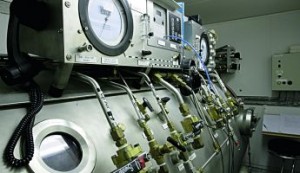Beginner swimmers should dive with caution, or use diving tables or computers to avoid getting sick. decompression sickness (DCI). Experienced divers typically choose a depth chart 10 feet (3 meters) deeper than the standard procedure. This practice is highly recommended for all divers, especially if the diving takes place in cold water or the diving takes place in difficult conditions. Divers diving with a diving computer should be careful about approaching non-decompression limits, especially if the dive is deeper than 100 feet (30 meters).

Avoiding the above risk factors (deep / long diving, deep or dive exercises) will help to reduce decompression sickness the possibility of obtaining. If the diver is exposed to altitude or flying immediately after diving, this increases the risk of developing caisson disease. DANS has recently published guidelines for post-dive flights.
Arterial gas embolism
If the diver pops up without exhaling, the air trapped in the lungs may expand, damaging the lung tissue, causing lung barotrauma, resulting in gas bubbles entering the arterial bloodstream. It divides them into cells in the body in proportion to the blood flow. Because the brain receives most of the blood flow, it is the most important organ where bubbles can disrupt circulation if they get stuck in small blood vessels.
It is an arterial gas embolism, or AGE, which can be considered the most serious type of DCI. Sometimes, the diver performs a panic takeoff or holds his breath during takeoff. However, AGE can also occur when take-off appears to be normal, and lung disease may exacerbate the risk of developing AGE.
The most dramatic manifestation of an embolism is when a diver emerges unconscious, or a diver who loses consciousness 10 minutes after emergence. These cases are critical and require urgent evacuation and assistance.
On the other hand, embolism can cause symptoms of neurological dysfunction, such as a feeling of tingling or numbness, a feeling of weakness without obvious paralysis, or a disturbance of thinking. In these cases, the diving medical professional must perform a thorough examination to rule out other causes of the disease.
Like DCS, mild symptoms can be attributed to a cause other than diving, which only delays treatment. Sometimes the symptoms may disappear spontaneously and therefore the diver does not seek help. The consequences are similar to untreated DCS: there may be residual brain damage that may worsen with each subsequent AGE.
AGE symptoms
- dizziness
- visual disturbances
- chest pain
- disorientation
AGE features
- bloody foam from the mouth or nose
- paralysis or weakness
- convulsions
- respiratory arrest
- death
Currently, cerebral embolism accounts for 10 percent of all DCI cases that occur within a year. The number of cases of AGE has decreased since the last decade, while the total number of cases was 18 percent in the late 1980s and early 1990s, then it has decreased since then. By 1997, that number had dropped to 7-8 percent.
In 2001, 7-8 percent of AGE cases were officially reported, but in 2002, the number dropped to 6.6 percent. It is believed that one of the reasons for the decrease in the number of cases is the appearance of diving computers, which help divers to maintain the take-off speed.
AGE prevention
Keep calm and breathe normally during takeoff. Various lung ailments, such as asthma, infections, cysts, etc., can cause a diver to develop an embolism. If you have any of the above, then you should seek an examination from a doctor who specializes in diving medicine.
AGE treatment
DCI treatment is recompression. However, the early treatment of embolism and caesarean section is the same. Although a diver with severe DCS or embolism requires urgent decompression for final cure, it is important that his condition be stabilized at the nearest medical facility before being transported to the hospital ward.
Initial exposure to oxygen is very important and can significantly reduce symptoms, but this should not change the treatment plan. Because the symptoms of embolism and severe caesarean section may disappear after initial oxygen respiration, but may reappear later. Therefore, always contact DAN or a physician familiar with the medical aspects of diving as soon as symptoms of DCI appear, even if their symptoms have disappeared.
Treatment includes compression similar to compression at a depth of 60 feet and breathing of a high-oxygen gas at a pressure ranging from 2.8 atmospheres to 3.0 atmospheres. Postponement of treatment carries a high risk of residual symptoms, after which these initially easily preventable lesions may become irreversible. After stopping treatment for 24 hours or more, treatment may become ineffective. However, although there have been delays, consult a dental practitioner to determine the effectiveness of possible treatment.
Sometimes, there may be residual symptoms after treatment. Sensitivity in and around the joints after DCS exposure is normal and disappears within a few hours. However, in severe DCI, neurological dysfunction may be felt even after vigorous treatment. In these cases, further treatment is required in addition to physical therapy. The good news is that starting treatment early will completely eliminate all symptoms of the disease.
In the article "Decompression sickness Prevention and Arterial Gas Embolism ”uses information from DAN (diversalertnetwork.org)

